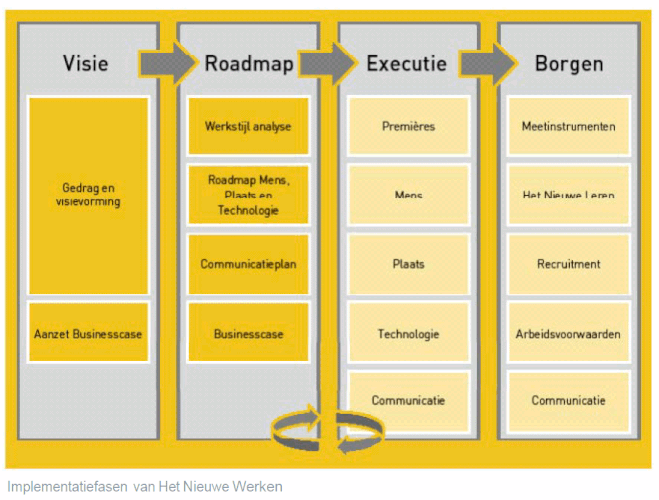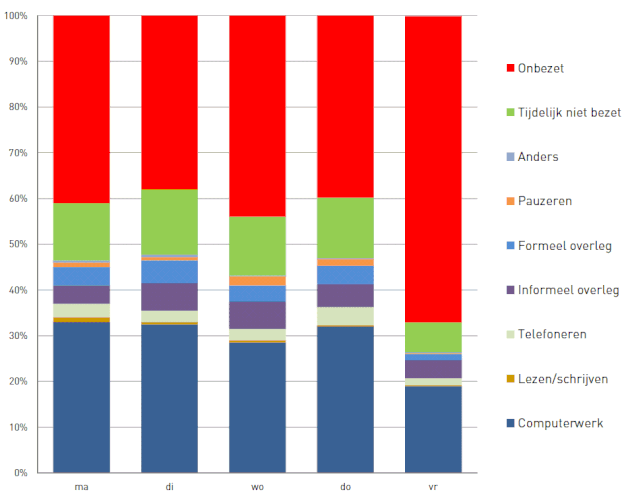Behaviour change is the success factor
Governmental organizations want to be an attractive employer, now and in the future. This should include a virtual working environment and staff which is able to work independent of time and place. Employees are given more responsibility, have a high level of task maturity and a good balance between work and private life. The cooperation and knowledge sharing among employees is optimal. The New Way of Working (HNW) is an important part of the Government for the Future program. HNW stands for making the work more effective, efficient and more enjoyable for both the organization and the employees. It is mainly a change in culture and mentality, using the latest technology to make the connection between people. HNW is explicitly not about telecommuting or buying laptops. TNWoW requires a new type of organization in which employees:
- function with confidence, freedom, responsibility and connection as key concepts;
- focus on results;
- have free access to knowledge and information;
- are able to work independent on place and time.
Housing Development versus organizational development
Many organizations base their choice to switch to TNWoW on housing issues or a housing problem. Most TNWoW projects are accompanied by the transition to a new working environment characterized by increased transparency, interaction and flexibility. Various disciplines are involved in transformation processes, including organization experts, housing consultants, architects, etc. All these actors have to deal in their own way with the clients, decision makers and users of the future situation. That makes the challenge per definition multidisciplinary, and the ideal solution per definition integral.
In particular, the interaction between organizational development processes and housing transitions intrigues. From the perspective of organizational development a change of the physical work environment is a potential catalyst, but in practice it could dominate the entire process, allowing the organizational development to receive little attention or even be obstructed. From the perspective of the housing transition an organizational change generates potentially much useful input for developing a custom solution, but in practice one must be careful that this information is not too late, too vague and variable, making that the housing project delays and the budget derails.
Approach
Each TNWoW project is unique, yet successful projects have a similar approach. They go through the next four phases:
creating a shared vision of why your organization wants to work with HNW and what the tangible and measurable results will be. Also a start will be made for the business case to gain insight into what this way of working will yield.
preparation of the roadmap that describes the steps you need to put the vision into reality. How do you work today, how will that change what you need for this in terms of attitude, behavior, knowledge and expertise, in the field of housing and in the field of technology? In addition, the communication plan is written. Finally, based on the roadmap, the business case will be completed so you will know what investments are needed and what will be the outcome.
the execution, in which the roadmap will be implemented and in which interim adaptation will occur. You will start with one or more premieres to test in practice whether you have achieved the desired result. After the eventual adjustment of the interventions you will get to work on a wider basis in the organization.
safeguarding of the change. People are just like memory metal, prone to fall back into old behavior. In this phase you will ensure that the change is durably cemented in your organization. You will do that by measuring, continuing to communicate and by adjusting several instruments to the new situation, such as for example the filling of vacancies with people who fit with the new way of working.
Pitfalls
1. Lessened social cohesion
Because you see each other less often and the contact moments are partially virtual the contact is not just decreasing, but also becoming more businesslike. There is a danger there. It is precisely the more informal contacts that forge a stronger connection with each other and with the organization. You will have to invest energy in the strengthening of the mutual bond.
2. Burn-out because of the New World of Work
If you get a lot of pleasure out of your work, quitting can be hard. The telephone is always on without exception, e-mail can be read and answered always and everywhere, and social media are never far away. It is hard for people to distinguish between always being able to work and actually always working. The telephone still has an off-switch, which is there for a good reason. A rubber band can not survive more and more tension, because if it does not relax now and then, it will break. The same is true for people. A good balance between work and private life is important for everyone.
3. Not integral
Organizations tend to look at the New World of Working as three projects: one for accommodation, one for IT and one for the mental side. Give everybody a smartphone, establish flexible working places and implement a leadership program. If you approach it in that manner, you will miss a lot of possibilities. Practical experience has shown us that only an integral approach leads to the best result.
4. Satisfaction = Result – Expectation
If the management of an organization indicates that it wants to work with a form of the New World of Working, then it is important to manage the expectations. If you tell an employee that he or she can pick his or her own new communication tools, that will usually result in happiness. The employee will get to work and picks an ideal set of € 1.200,-. If you subsequently explain that the budget was a mere € 700,-, then odds are that the happiness will turn into disappointment. Because the expectation was too high, the satisfaction is decreasing, even though the result could still be good. This leads to unnecessary negative feelings.
5. Communication
Finally, support through direct involvement is of crucial necessity. Communication plays a major role there. Often this tool is used too late or incorrectly. Especially with large organizations there can be a tendency to communicate about people, instead of with people. Present employees with a stage to present their opinions and handle them seriously. Even if there is nothing to communicate you can still pass that on.
Efficient accommodation with the New World of Working
What can the New World of Working signify when it comes to accommodation expenditure? ABC Management Groep regularly examines workplaces and activities at the clients’ locations. These accurate investigations present an insight into the actual filling of the workplaces and analyze the activities of the employees. It turns out that traditional workplace concepts are very inefficient. On average, the workplace is occupied for less than 40%, as employees are having a meeting, an appointment outside or a day off. If the workplace is occupied it is mostly a lot of computer work that is being done.
The fact that an average of 40% of the workplaces in a traditional organization is occupied is not a new fact. Similar investigations of about 10 years ago present the same image. This means that in the area of accommodation and operating expenses significant cost savings can be realised, if the choice is made for workplaces to not be bound to a person and to be usable multiple times. National benchmark figures tell us that administrative organizations have, on average, the following annual expenses per workplace:
Knowledge sharing and development
ABC Management Group is active in several think tanks and external project groups for the purpose of sharing knowledge and developing new tools. With experts and professions from the working field, questions regarding HNW are dealt with integrally. ABC Management Group is, for example, an active member of the project group Work Place Design under the leadership of the Hanze University Groningen where accommodation is approached as a management tool for the New World of Work.
This article appeared in the IGG Manual of the built environment 2012 and is placed here with the permission of IGG Bointon de Groot. This article is also available as PDF.
About the authors
Kees Froeling, is solution manager New World of Work at Human Capital Group, part of Conclusion. He assists organizations with their own version of the New World of Work by using his available expertise in HRM, Communication, Organization and Technology in conjunction. Kfroeling@conclusion.nl Bart Atema, project manager at ABC Management Groep, involved in several accommodation trajectories in the preparation phase and execution phase in which the organization makes the transition to HNW. With his knowledge of both worlds the bridge between the New World of Work and the accommodation is solidified and strengthened. b.atema@abcmg.nl


